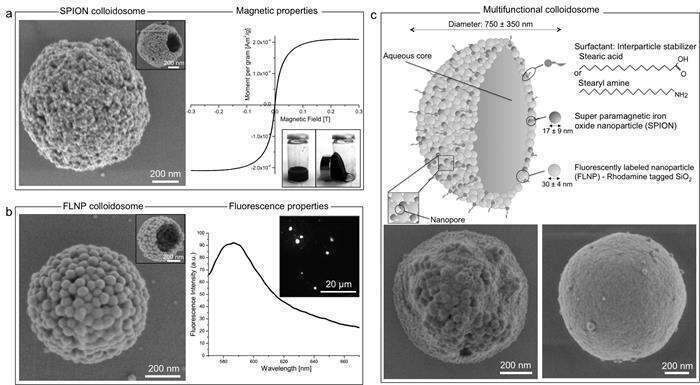Submicron colloidosomes are a promising new type of microcapsule with the potential to significantly improve the field of nanomedicine. Colloidosomes consist of a semipermeable shell of self-assembled colloidal particles. The shell exhibits small pores that are formed between the individual nanoparticles that may allow a controlled release of encapsulated active agents.1 In our previous work, we demonstrated the synthesis of colloidosomes with diameters below 1 µm based on a single kind of nanoparticle like metal oxides2 or nanodiamonds.3 Now, we introduce multifunctional submicron colloidosomes using nanoparticles with distinct physical properties that are formed by the combined assembly from different kinds of nanoparticles.

First, by incorporating superparamagnetic nanoparticles (SPIONs) within the colloidosome-forming shell it is possible to design microcapsules with responsiveness to an external magnetic field (Figure 1-a). After colloidosome-loading with active agents this physical property may be utilized for hyperthermia cancer treatment or drug-targeting. Second, fluorescently labeled nanoparticles (FLNPs) were incorporated within colloidosomes (Figure 1-b) for the purpose of cell tracking or in order to study their interactions with cellular subunits. The combined assembly of multifunctional submicron colloidosomes from SPIONs and FLNPs (Figure 1-c) was achieved via the formation of Pickering emulsions. Next to assessing the functionality of the colloidosomes, the capsules were thoroughly characterized using electron microscopy, DLS, and interfacial shear rheology.
References:
(1) Dinsmore, A. D.; Hsu, M. F.; Nikolaides, M. G.; Marquez, M.; Bausch, A. R.; Weitz, D. A. Science 2002, 298, 1006–1009.
(2) Bollhorst, T.; Grieb, T.; Rosenauer, A.; Fuller, G.; Maas, M.; Rezwan, K. Chem. Mater. 2013, 25, 3464–3471.
(3) Maas, M.; Bollhorst, T.; Zare, R. N.; Rezwan, K. Part. Part. Syst. Charact. 2014. in print.
bollhorst@uni-bremen.de